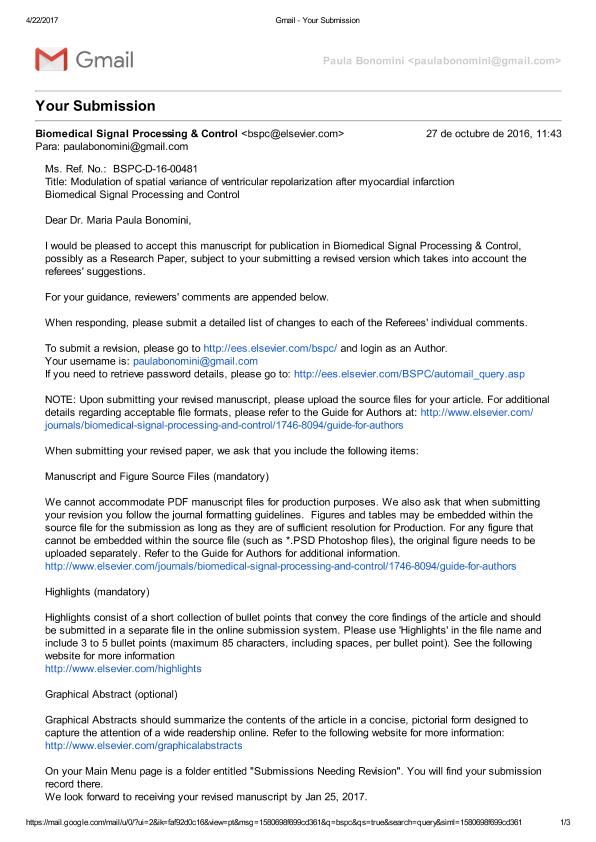Mostrar el registro sencillo del ítem
dc.contributor.author
Bonomini, Maria Paula

dc.contributor.author
Arini, Pedro David

dc.date.available
2017-06-28T18:31:31Z
dc.date.issued
2017-04
dc.identifier.citation
Bonomini, Maria Paula; Arini, Pedro David; Modulation of spatial variance of ventricular repolarization after myocardial infarction; Elsevier; Biomedical Signal Processing and Control; 34; 4-2017; 214-219
dc.identifier.issn
1746-8094
dc.identifier.uri
http://hdl.handle.net/11336/19010
dc.description.abstract
Myocardial infarction (MI) alters spatial features of thesurface electrocardiogram. Spatial variance of the T-wave (SVT )describes the interlead dispersion about a mean T-wave morphology. SVTwas linked to arrhythmiavulnerability and sudden cardiac death. In this work, we studied theevolution of SVT over the healing (MI7, up to 7 days after MI) and healed(MI60, from 60 days on post-MI) stages following MI. A control group(n=49) was compared to paired MI7 and MI60 groups (n=39). Fiverepresentative sets of frontal and precordial leads were analyzed: I-IIIII,V1-V2-V3, V4-V5-V6, aVF -V2-V5 and II-aVF -V5. SVT index signicantlyincreased at MI7 (p<0.05) in four out of ve sets and returned towardscontrol values at MI60 (p=NS) on patients without ventricular tachycardiaand/orventricular brillation (VT/VF). The preferential combination of ECG leadsresulted aVF -V2-V5, since it showed the strongest modulation over postMI time. In order totest whether such a modulation was maintained on the presence of VT=VF),recordings from VT=VF patients were also analyzed. SVT modulation waslost in the VT=VF group, signicantly increasing from controls at MI60(p<0.05) for all tested sets of leads. In conclusion, SVT modulation overMI7 and MI60 would signal a good recovery from MI, whereas lack of thismodulation could herald a VT=VF event.
dc.format
application/pdf
dc.language.iso
eng
dc.publisher
Elsevier

dc.rights
info:eu-repo/semantics/openAccess
dc.rights.uri
https://creativecommons.org/licenses/by-nc-sa/2.5/ar/
dc.subject
HEALING AND HEALED PHASE
dc.subject
MYOCARDIAL INFARCTION
dc.subject
SPATIAL VARIANCE
dc.subject
VENTRICULAR FIBRILLATION
dc.subject.classification
Ingeniería Médica

dc.subject.classification
Ingeniería Médica

dc.subject.classification
INGENIERÍAS Y TECNOLOGÍAS

dc.title
Modulation of spatial variance of ventricular repolarization after myocardial infarction
dc.type
info:eu-repo/semantics/article
dc.type
info:ar-repo/semantics/artículo
dc.type
info:eu-repo/semantics/publishedVersion
dc.date.updated
2017-06-26T19:51:30Z
dc.journal.volume
34
dc.journal.pagination
214-219
dc.journal.pais
Países Bajos

dc.journal.ciudad
Amsterdam
dc.description.fil
Fil: Bonomini, Maria Paula. Consejo Nacional de Investigaciones Científicas y Técnicas. Oficina de Coordinación Administrativa Saavedra 15. Instituto Argentino de Matemática Alberto Calderon; Argentina. Universidad de Buenos Aires. Facultad de Ingenieria. Instituto de Ingeniería Biomédica; Argentina
dc.description.fil
Fil: Arini, Pedro David. Consejo Nacional de Investigaciones Científicas y Técnicas. Oficina de Coordinación Administrativa Saavedra 15. Instituto Argentino de Matemática Alberto Calderon; Argentina. Universidad de Buenos Aires. Facultad de Ingenieria. Instituto de Ingeniería Biomédica; Argentina
dc.journal.title
Biomedical Signal Processing and Control

dc.relation.alternativeid
info:eu-repo/semantics/altIdentifier/url/http://www.sciencedirect.com/science/article/pii/S1746809417300228
dc.relation.alternativeid
info:eu-repo/semantics/altIdentifier/doi/http://dx.doi.org/10.1016/j.bspc.2017.01.014
Archivos asociados
